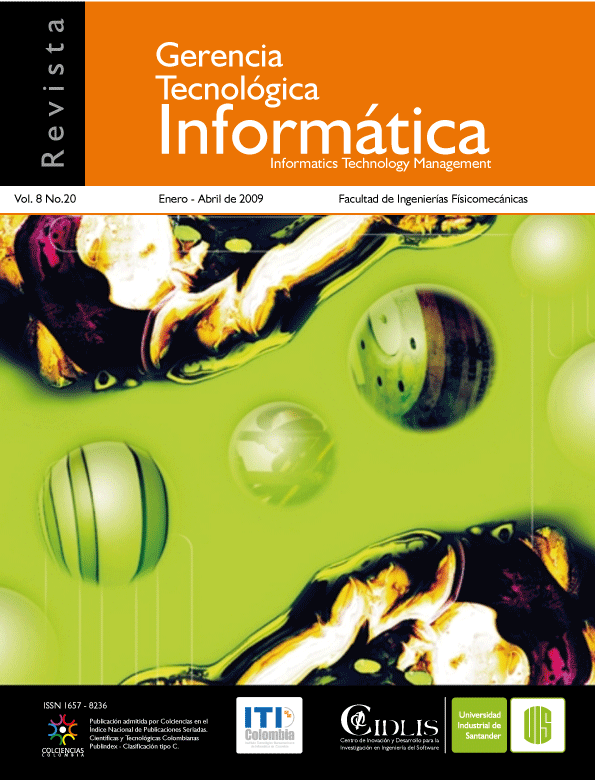PLANTEAMIENTO DE UN MODELO PARA LOS SERVICIOS GRID DE NOTIFICACIÓN Y REGISTRO DE INFORMACIÓN GEOGRÁFICA
Published 2010-07-23
How to Cite
Abstract
RESUMEN
Con este artículo se presentan los resultados de la investigación desarrollada, en cuanto al planteamiento de un modelo para servicios GRID de notificación y registro de información geográfica, planteamiento de un modelo para servicios GRID de notificación y registro de información geográfica, generada por una red inalámbrica de geosensores, el cual se basa en las premisas que el OGC (Open Geospatial Consortium) propone a través del SWE (Sensor Web Enablement), debido a que dicha propuesta es realizada para servicios WEB.
Se presenta un modelo teórico, el cual es una adaptación del propuesto por el SWE; luego expone el modelo del caso de estudio, en el cual se desarrolla el servicio GRID, dicho servicio fue implementado sobre GLOBUS TOOLKIT (middleware para el desarrollo de servicios GRID) y OGSA-DAI (Open Grid Service Architecture Data Access and Integration - middleware para acceso a recurso de datos sobre la GRID); los clientes acceden a los servicios a través de un portal GRID (desarrollado por otro proyecto[1]), para lo cual se desarrollaron los portlets ("aplicación basada en java que se puede acceder a través de un portal" [1] necesarios para usar los métodos expuestos por el servicio.
Al implementar el modelo teórico por medio del caso de estudio, se comprueba que dicho modelo es válido, y que puede servir como base para implementaciones futuras no solo de servicios para el manejo de información geográfica, sino que podría generalizarse para manejo de cualquier tipo de información generada por una red inalámbrica de geosensores.
PALABRAS CLAVES: Computación GRID, Redes Inalámbricas de Geosensores, Sensor Web Enablement, Servicios GRID, OGSA-DA.I.
ABSTRACT
In this paper the author attempts to show the results of the investigation carried out to the establishment of a model for GRID services to notification and registry of geographic information, generated by a wireless network of geosensors, which is based on the premises that the OGC (Open Geospatial Consortium) proposes through SWE (Sensorial Web Enablement), due to the fact that the above mentioned offer is realized for WEB services.
There appears a theoretical model, which is an adaptation of the proposed one by SWE; soon it exposes the model of the case of study, in which GRID service is developed, the above mentioned service was implemented on GLOBUS TOOLKIT (middleware for the development of GRID services) and OGSA - DAI (Open Grid Service Architecture Data Access and Integration - middleware for access to resource of information from the GRID); the clients can accede to the services through a GRID portal (developed in another research), for which they were developed portlets (application based on java that can be acceded through a portal), required to use the methods exposed by the service.
When the theoretical model was implemented by means of case of study, it was prove that this model is valid, and that it can serve as basis for future implementations, not only of services for the handling of geographic information, but that could become general for handling any kind of information generated by a wireless network of geosensors.
KEY WORDS: GRID Computing, Wireless Geo-sensor Networks, Sensor Web Enablement, Servicios GRID, OGSA-DAI.
Downloads
References
- MONTAÑEZ, Sandra y PÉREZ, José. Modelo dePortal para Laboratorio de Computación Grid. Revista Ingeniería y Universidad. Universidad Pontificia Javeriana. Bogotá D.C., v.12, n.2, 2008. ISSN0123-2126.
- ANANDA, A.; CHOON CHAN, Mun y TSANG OOI,Wei. Mobile, wireless, and sensor networkstechnology, applications and future directions.En IEEE Press 2006.
- BÁEZ, Carmen y PÉREZ, José. De las redes inalámbricas de sensores a la web de sensores. Revista Gerencia Tecnológica Informática. Publicaiones UIS. Vol 6. No. 6. 2007. Pág. 108
- The Open Geospatial Consortium. [en línea]. Consultado el 15 de Marzo de 2008. Disponible en :http://www.opengeospatial.org/ .
- INIESTO ALBA, M. J. y CARBALLO CRUZ, P. SensorWeb Enablement: Todos los sensores conectadosa la Web. En : CONGRESO NACIONAL DE TOPOGRAFÍA Y CARTOGRAFÍA (VIII : 2004 : Madrid).VIII Congreso Nacional de Topografía y Cartografía. Madrid : 2004.
- Open GIS Consortium Inc. Web Notification Services. 2003.
- Refractions Research Inc. Web Registry ServiceResearch Document. 2004.
- Definición Globus Toolkit. [en línea]. Consultado el30 de Abril de 2008. Disponible en : http://www.globus.org/
- OGSA-DAI Project. Qué es OGSA-DAI?. The University of Edinburgh. 2005 - 2008. Reino Unido.[en línea]. Consultado el 1 de Mayo de 2008.Disponible en: http://www.ogsadai.org.uk/about/ogsa-dai/
- ANTONIOLETTI, Mario, Et. al. The Design and Implementation of Grid Database Services in OGSADAI. 1EPCC, University of Edinburgh,. S.f. ReinoUnido. [en línea]. Consultado el 14 de Marzo de2008. Disponible en: http://aspen.ucs.indiana.edu/CCPEwebresource/c815watson/c815OGSADAI-6.pdf
